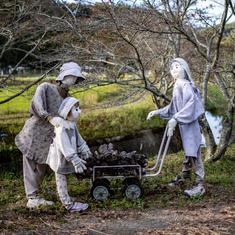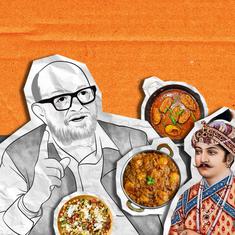“Can you make out the difference?” Papa would relish quizzing anyone sharing our lunch of faux machchli. The raw-banana “fish” was a favourite dish on my grandparents’ table. Mostly a winter afternoon staple, this delicious curried “fillet” was eaten with arhar dal and plain aromatic Basmati rice. It was food that offered great joy to my grandparents, who were vegetarians, Barima a lifelong one and LC in his later years.
Kele ki machchli, or “fish” fashioned from plantain, was a simple dish where the raw banana flavour was cleverly masked and the landlocked north Indian palate tricked into believing that this was indeed a home-style fish curry. The curry was flavoured with kasoori methi, or dried fenugreek leaves. The banana itself was cut lengthwise in the shape of fillets, coated with gram flour and fried till crisp. These fillets were then simmered in a thick onion and tomato gravy for just a couple of minutes so that they retained their texture while soaking up the flavours of the curry.
I have to admit it wasn’t a bad approximation of the way in which most north Indian homes cook fish, masking its flavour and smell with spices and herbs, in this case the very powerfully fragrant dried fenugreek. Fenugreek and fish remains a classic north Indian combination. In all probability, kele ki machchli was a later-day invention in the home of my grandparents – either to make the humble plantain more palatable or to simply replicate non-vegetarian flavours and textures for vegetarians in the household. But such paheli ka khana, food that flummoxes the diner, seems to have been a tradition with Kayasth households anyway.
I first came across references to paheli ka khana in Hyderabad. Old Nizami families and upper-class Muslim homes have an entire repertoire of quirky dishes meant to trick the palates of guests through the creation of interesting culinary illusions and, in the end, elicit applause for sheer inventiveness and innovation. These dishes would often be presented as a jest. For instance, a newly married bridegroom enjoying the hospitality of his in-laws could be presented with a lukhmi, a traditional pie, as part of the meal in his honour. When poked open, the pastry shell would reveal a live quail that would fly away!
Cooks and ladies ruling the kitchens invested a considerable amount of time and talent perfecting such tricky and undoubtedly complicated sleights of hand.
Ingredients would be masked with flavouring and spicing, and made to look completely different from what they actually were. It was a style of cooking perfected in many royal kitchens of princely India where entertainment and cuisine were looked upon as art forms and enjoyed the patronage of royal and upper-class families. It was also a style of cooking completely at odds with the way in which we are increasingly looking at food today – where ingredients take centre stage and their intrinsic flavours are highlighted rather than disguised. But that is another story and quite another argument.
In Kayasth households, much like paheli ka khana, an entire strand of cooking involved dishes that were not what they seemed. Essentially, these were vegetarian dishes made to look, feel and taste like non-vegetarian dishes, like kele ki machchli, or moong dal ke shami kebab, or atte ka keema, and so on. For a community in which most of the women remained vegetarian for religious reasons even as the men adopted meat eating (and other cultural nuances) of the ruling classes, it must have been quite natural to experiment and come up with vegetarian alternatives to popular non-vegetarian dishes. What is interesting is that never having tasted meat at all, Kayasth women were still able to replicate quite dexterously, fairly authentic meaty flavours from humble ingredients in their kitchen.
Barima, for instance, despite never having tasted liver, was adept at making kaleji ki subzi – false liver. (My family, in any case, has been quite the exception amongst the clan for eschewing the typical bhuna gurda kaleji favoured in other Kayasth homes.) Soaked and ground moong dal would be seasoned with garlic and garam masala, steamed in little muslin bags and cut into little irregular shaped dumplings. These were then cooked in a thick gravy, with the masala and texture of the nuggets evoking a masala-clad, bhuna liver preparation. Since even real liver preparations involved hiding the strong smell and taste of offal by cooking it in milk, bhunoing it over a slow fire and coating it in masala, both the end results tasted quite similar.
Raw jackfruit, regarded as the “meat for vegetarians” because of the way it looks and because of its texture, was another ingredient commonly used in faux non-vegetarian recipes. Cooking the most tender of small jackfruits available only during the monsoon was an art in itself. In the assorted UP towns where my grandparents stayed for the duration of LC’s Railways career, there was always a jackfruit tree or two either within the bungalow compound that formed the official residence or in the vicinity.
Kathli, as the smallest, most tender of the raw fruit was colloquially called, was carefully picked by the household help, brought home, peeled painstakingly after their palms had quite literally been greased, cut lengthwise into rectangles and then lovingly bhunoed just like pieces of tender goat meat chops would be. The treatment of both the meat and vegetarian dishes was quite the same: slowcooking in yoghurt, with a substantial addition of onions and whole and powdered spices like badi elaichi, or black cardamom with its nutty aroma, cinnamon, cloves, et al. No tomatoes were used – no one would think of using these as the souring agent in a meat curry, after all. True to the Mughal style of cooking, yoghurt was the souring agent of choice and bhuna was the main method of cooking both vegetables and meats.
Jackfruit was also used in tahiri – the vegetarian equivalent of a meat pulao. But first, let us get the definitions right. There is no such thing as “veg biryani” and a pulao always means a goat meat pulao. Belonging to a Kayasth family means that a little bit of food snobbery inevitably exists in your bloodstream, and even though I am quite democratic in my tastes, my blood rages just a little bit each time I find people – and restaurant menus – waxing eloquent about “veg biryani” or “veg pulao”.

Excerpted with permission from Mrs LC’s Table: Stories about Kayasth Food and Culture, Anoothi Vishal, Hachette India.










